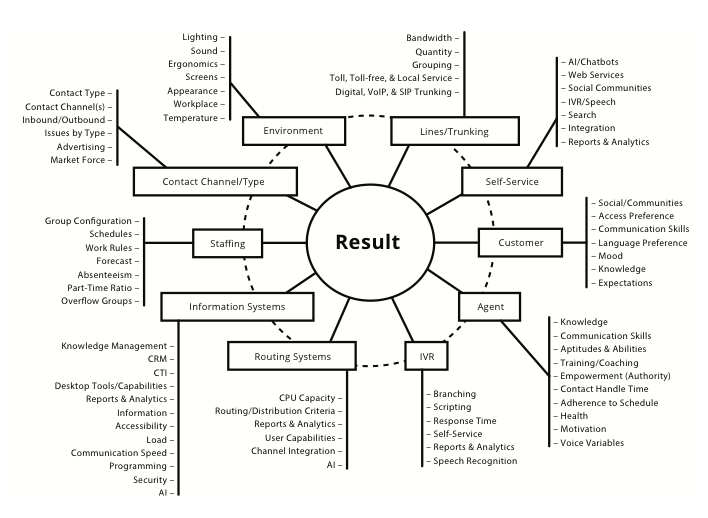The third principle in this series, Improving Quality and Performance in Customer Experience, focuses our attention on the bigger picture – the processes within an organization. A process is a “system of causes.” (Note: in the context of quality and process improvement, “system” refers to the system of causes or processes, not a technology.)
Every organization is an expansive system of causes. Within the organization, every department is a system of causes. Within each department, each team or group is its own system of causes. You can continue to drill down until, with a customer experience perspective, every interaction with a customer is its own system of causes.
Let’s take a customer contact center as an example. In the illustration, the central focus of the process can be any high-level measurement or result that you want to achieve. Note that most of the items are the responsibility of management and the organization, not individual employees. Also note that just about everything is interrelated, so the causes of performance problems are often difficult to isolate and measure.
 This illustration leads to a principle that is at the heart of the quality movement: there is little use urging employees to improve quality without making improvements to the system of causes. Many of the things that contribute to quality are beyond their direct control, such as having good training, the right tools, accurate information and a logical workflow. The system of causes—the process—is where the leverage is.
This illustration leads to a principle that is at the heart of the quality movement: there is little use urging employees to improve quality without making improvements to the system of causes. Many of the things that contribute to quality are beyond their direct control, such as having good training, the right tools, accurate information and a logical workflow. The system of causes—the process—is where the leverage is.
Some managers try to force change by setting strict standards for employees. But that will not improve underlying processes and usually is detrimental. So where do you begin? You can look at the most important performance indicators and ask some key questions. What are customers saying? Where are you making mistakes? What levels do you want to raise (or lower)? Where are the innovation opportunities?
But tracking results isn’t the same as improving them. To make improvements, you have to work on the factors that cause these outputs to be where they are. In other words, you have to work at a deeper level—the root causes.
Note: This post is part of a series on Improving Quality and Performance in Customer Experience:
Principle #1: Quality Must Be Based on Customer Needs and Expectations
Principle #2: Quality and Access to Service Work Together